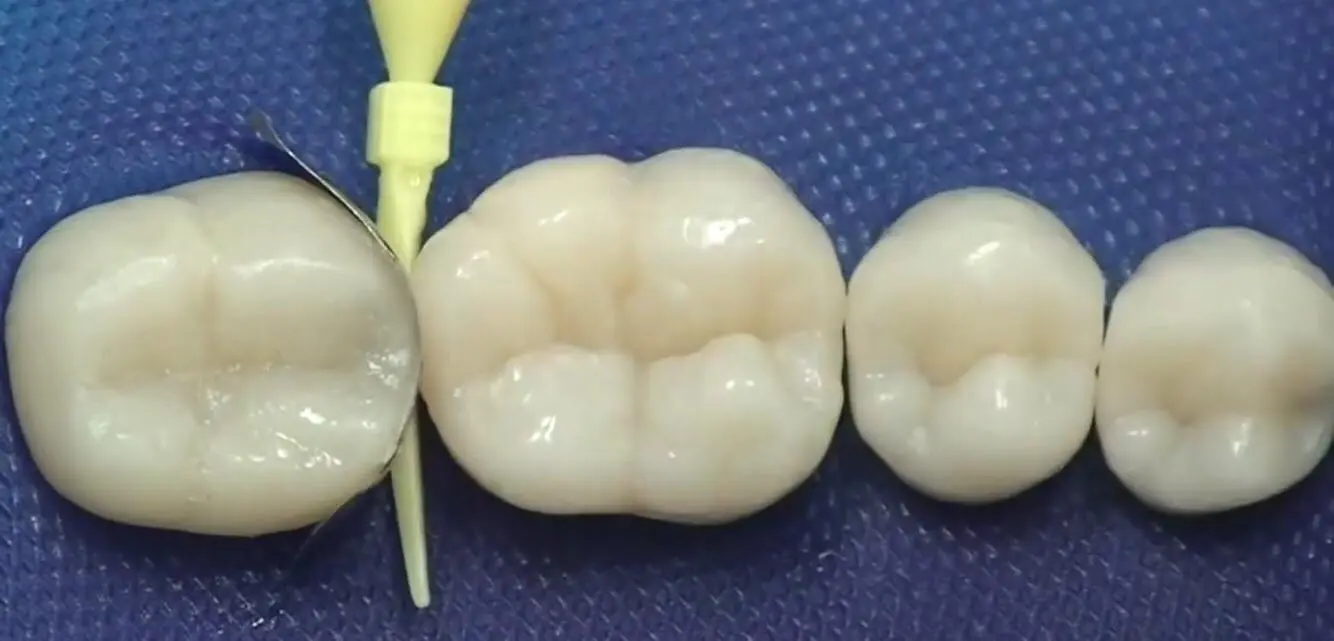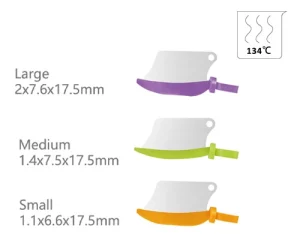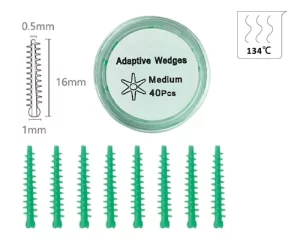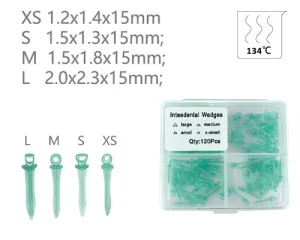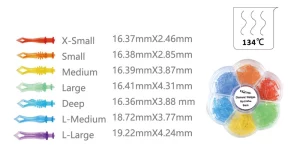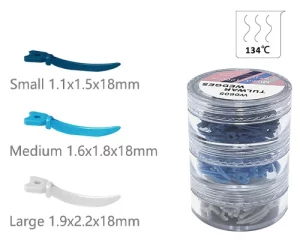Obwohl klein, Zahnkeile spielen eine unersetzliche Rolle in der restaurativen Zahnheilkunde. Sie werden hauptsächlich zur Zahntrennung verwendet, Stabilisierungsmatrixbänder und Gestaltung der Ränder der Restaurationen. Abhängig vom Material und Design, Die klinische Leistung und Verwendung von Keilen variieren. In diesem Artikel, Wir werden die Arten von systematisch analysieren Zahnkeile, ihre materiellen Eigenschaften, ihre Hauptfunktionen und ihre Anwendung bei der Füllung und Wiederherstellung.
1. Arten von Zahnkeilen und Materialeigenschaften
Plastik -Zahnkeile
Material: Oft aus medizinischem Polypropylen hergestellt (Pp), flexibel.
Vorteile:
- Mäßige Elastizität verringert den Druck auf Zahnfleisch.
- Kann bei hohen Temperaturen sterilisiert werden und ist für die Wiederverwendung geeignet.
Nachteile:
- Begrenzte Unterstützung, nicht für Fälle mit geeignet tiefe Karies oder enge Lücken.
Beispielanzeige:
- Zahnwächter (GD-5675): mit Loch mit rblade
Drei Größe: Groß/mittel/klein

- Anpassungsfähige Keile (GD-5677): mit festem innerem Plastikkern, mit Silikon bedeckt

- Harz Zahnkeile (GD-5678): vier Größe, Xs/s/m/l

- Diamantkeile (GD-5679): sieben Größe, X-small/klein/mittel/groß/tiefe/l-medium/l-large

- Tulwar Keile (GD-5680): Drei Größe, Klein/mittel/groß

Hölzerne Zahnkeile
Material: Meistens Birken oder Kiefern, sterilisiert. Birkenkeile mit einem Wassergehalt von 12% kann sich um bis zu expandieren 18.7% In 30 Minuten in einer Gingivalflüssigkeitsumgebung. Diese adaptive Eigenschaft macht sie besonders geeignet für Fälle von Gingivalrezession bei alten Patienten. Jedoch, Sorgfältig sollte aufgenommen werden: Überexpansion kann zu übermäßigem Druck auf die parodontale Membran führen, Auslösen postoperativer Empfindlichkeit.
Vorteile:
- Natürlich Wasserabsorben und anschwellbar, intraoperativ besser an die Lücke passt.
- Starr, Geeignet für die hohe Stärke der Höhlen der Klasse II geeignet.
Nachteile:
- Unbrauchbar, Überexpansion kann Beschwerden verursachen.
Probenanzeige:

Andere Typen
- Metallkeil: Selten, häufig für die vollständige Kronenvorbereitung oder spezielle restaurative Szenarien verwendet.
- Silikonkeil: weich und flexibel, geeignet für ästhetische Restaurationen, aber teurer.
2. Die drei Kernfunktionen des Zahnkeils
Zahntrennung
- Trennt die benachbarten Zähne vorübergehend durch 0.2-0.5 mm mit leichter mechanischer Kraft, um einen Betriebsraum zu schaffen.
- Dies verhindert,.
- Klinische Studien haben gezeigt, dass der ordnungsgemäße Einsatz von Keilen das Risiko einer Nahrungsmittelimpaktion durch bis zu bis hin zu verringern kann 60%.
Matrixbandstabilisierung
- Zahnkeile können beim Fixieren des Formteils helfen, Verhinderung der Leckage des restaurativen Materials und der Gestaltung der idealen Kontur.
- Hohlraum II Restorationen: die Kombination mit der Matrixbänder Stabilisierung ist die klassische Lösung.
- Restaurationen der Hohlraumklasse V: Normalerweise in Kombination mit einer gekrümmten Formplatte.
Zahnfleischschutz und Blutstillung
- Zahnkeile können oberhalb des Zahnfleisches einen gewissen Schutz bieten.
- Nachdem der Zahnkeil in den Zahn eingeführt wurde, Es wird ein leichter Druck auf das Zahnfleisch ausgeübt, Reduzierung der Blutung während der Operation.
3. Anwendungskompetenzen beim Füllen und Reparieren
So wählen Sie den richtigen Keil aus
| Kriterien | Empfohlener Keiltyp |
|---|---|
| Enger interproximaler Raum | Holzkeile, Es dehnt sich aus und passt zusammen, wenn es nass wird |
| Breiter interproximaler Raum | Plastikkeil, elastische Passform |
| Leichtes Harz | Klare Kunststoffkeile, erleichtern das Eindringen von Licht |
| Amalgamfüllung | Holzkeile, es kann stärkere Unterstützung bieten |
Geben Sie den Winkel und die Richtung ein
Der Zahnkeil sollte schräg von der lingualen oder bukkalen Seite des Zahns in den Interdentalraum eingeführt werden, und der Winkel sollte auf 30° bis 45° eingestellt werden. Der Hauptzweck dieses Winkeldesigns besteht darin, das Zahnfleischgewebe zu schonen, verhindern eine direkte Kompression oder ein Verkratzen des Zahnfleisches beim vertikalen Einführen, und reduzieren das Risiko einer postoperativen Zahnfleischrötung, Schwellung und Blutung.
Kontrolle der Einführtiefe
Die Spitze des Keils sollte etwa 0,5 mm etwas höher als der Rand der Restauration sein. Dieser reservierte Raum soll die Schrumpfung während des Aushärtungsprozesses nachfolgender Füllmaterialien ausgleichen (wie Harz), Sicherstellen, dass das Material nach dem Aushärten eng am Zahnrand haften kann und die Bildung von Lücken vermieden wird, die zu Sekundärkaries führen könnten.
Klinische Vorsichtsmaßnahmen
Vermeiden Sie übermäßigen Druck auf das Zahnfleisch: Während des Betriebs, Die Einführkraft des Zahnkeils sollte kontrolliert werden. Übermäßiger Druck kann die Bindungsbeziehung zwischen Zahnfleisch und Zähnen beschädigen, Dies kann zu einem postoperativen Zahnfleischrückgang führen. Klinische Statistiken zeigen, dass die Häufigkeit solcher Komplikationen ungefähr beträgt 3% Zu 7%.
Präzise Positionierung der Einlegeposition: Wenn der Zahnkeil versetzt eingesetzt wird (B. zu nahe an der Okklusionsfläche oder der Richtung der Wurzelspitze), Dies kann dazu führen, dass die Kontaktpunkte benachbarter Zähne zu locker sind, Dadurch wird die Stabilität der normalen okklusalen Beziehung beeinträchtigt. Bei den Patienten können Probleme wie schwacher Biss und Nahrungseinklemmung auftreten.
Tatsächlicher Fall: Reparatur eines tiefen keilförmigen Defekts
Am Beispiel der Reparatur eines tiefen keilförmigen Defekts des linken unteren ersten Prämolaren, Die spezifische Operation und die therapeutische Wirkung sind wie folgt:
- Präoperative Beurteilung: Der Patient war ein 45-jähriger Erwachsener. Der zervikale Defekt des linken unteren ersten Prämolaren hatte das tiefe Dentin erreicht, begleitet von offensichtlichen Kälte- und Hitzeempfindlichkeitssymptomen. Die visuelle Analogskala (VAS) wurde zur Beurteilung des Empfindlichkeitsgrades verwendet, mit einer Punktzahl von 6/10.
- Wichtige Operationstechniken: Erste, Benutze die Nr. 00 Gingivalinie zur Zahnfleischdrainage. Dann, Einen angefeuchteten Kiefernspalt einlegen und einwirken lassen 15 Minuten, bis es sich vollständig ausdehnt und die Zahnlücke erweitert. Nächste, Als Basis wird flüssiges Harz verwendet, Anschließend wird 3M Z350XT-Harz für die Schichtfüllung verwendet. Die Keile sollten aufbewahrt werden, bis das Harz zunächst ausgehärtet ist, bevor sie entfernt werden, um eine Materialverformung während des Füllvorgangs zu verhindern.
- Postoperative Wirksamkeit: Der Patient wurde nach der Operation ein Jahr lang nachbeobachtet. Die Untersuchung ergab, dass die Integritätsrate der Restauration erreicht wurde 98%, ohne Lockerung, Ablösung oder Sekundärkaries. Die Kälte- und Hitzeempfindlichkeitssymptome des Patienten verschwanden vollständig, und die okklusale Funktion normalisierte sich wieder.
4. Kaufkriterien für Zahnkeile
Materialssicherheit Priorität
Kernzertifizierungsstandards
Das Material und die Sterilisationsbehandlung des Keils müssen den professionellen medizinischen Standards entsprechen. Unterschiedliche Materialien entsprechen klaren Zertifizierungsanforderungen:
- Kunststoffkeile: Muss FDA haben (Lebensmittel- und Arzneimittelbehörde der Vereinigten Staaten) oder CE (Produktsicherheitszertifizierung der Europäischen Union) Zertifizierung von Polymeren in medizinischer Qualität. Der Kern muss Schadstoffe wie Phthalate vermeiden, die durch Kontakt migrieren und potenzielle Gesundheitsrisiken darstellen können. Die Konformitätszertifizierung ist die entscheidende Grundlage für die Gewährleistung der Materialsicherheit.
- Holzkeile: Ein kompletter EO (Ethylenoxid) Es muss ein Sterilisationsbericht vorgelegt werden, und aus dem Bericht sollte klar hervorgehen, dass die biologische Belastung ≤10⁻⁶ beträgt (D.h., Die Wahrscheinlichkeit, dass Mikroben nach der Sterilisation überleben, beträgt höchstens eins zu einer Million), Stellen Sie sicher, dass vor der Verwendung keine pathogenen Bakterien mehr vorhanden sind, um Kreuzinfektionen oder postoperative Entzündungen zu vermeiden.
Wichtige Punkte zur Vermeidung von Fallstricken bei der Beschaffung
Beim Kauf, Seien Sie vorsichtig bei Produkten, die nicht für medizinische Zwecke geeignet sind, und lehnen Sie diese insbesondere ab “Industrielle Holzkeile” ohne Markierung. Die meisten dieser Produkte werden aus Reststoffen der industriellen Verarbeitung hergestellt und keiner medizinischen Behandlung unterzogen. Sie können schädliche Chemikalien wie Formaldehyd enthalten. Bei Verwendung, Sie reizen nicht nur leicht das Zahnfleischgewebe, sondern können auch über die Mundschleimhaut aufgenommen werden, eine Gefahr für die Gesundheit des Patienten darstellen. Darüber hinaus, Es gibt keine einheitlichen Standards für ihre Größe und Härte, die die genauen Betriebsanforderungen der Zahnrestauration nicht erfüllen können.
Maximieren Sie die Größenanpassungsrate
Bei der Auswahl von Keilen, Es ist notwendig, die tatsächlichen klinischen Anforderungen zu kombinieren und die Größenanpassungsrate zu maximieren “präoperative Beurteilung + Multi-Spezifikationsreserve”.
Vor der Operation, Die Größe des benötigten Keils sollte zunächst anhand der Breite des Interdentalspalts des betroffenen Zahns ermittelt werden (wie zum Beispiel die Karieslücke im Zahnzwischenraum, keilförmiger Defektspalt) und die Zahnmorphologie (wie Milchzähne und bleibende Zähne, normale Zähne und geneigte Zähne).
Es wird empfohlen, einen Vorrat an Keilen in mehreren Größen anzulegen (wie dünn, Medium, dick, oder dünne und dicke Ausführungen für spezielle Zahnlücken) um eine schlechte Passform aufgrund unzureichender Einzelgröße zu vermeiden, Dies kann den Spaltöffnungseffekt beeinträchtigen oder eine Zahnfleischkompression verursachen. Dadurch wird sichergestellt, dass für verschiedene Fälle ein passendes Modell gefunden werden kann, Verbesserung der betrieblichen Effizienz und der Wiederherstellungsqualität.
5. Abschluss
Obwohl Zahnkeile klein sind und unbedeutend erscheinen, sie sind unverzichtbar “wichtige Nebenrollen” bei Zahnrestaurierungsoperationen. Von der Materialauswahl bis zum standardisierten Einsatz, Die präzise Kontrolle aller Verbindungen ist nicht nur die wichtigste Garantie für die Verbesserung der Stabilität der Restauration und die Reduzierung postoperativer Komplikationen, Sie können aber auch die Diagnose- und Behandlungserfahrung des Patienten effektiv verbessern und den Grundstein für eine langfristig gute Prognose legen.

